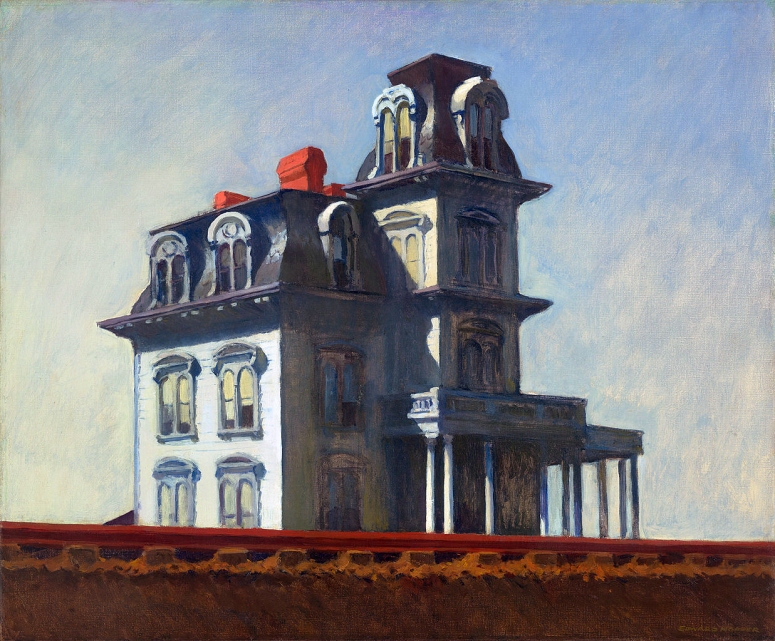Many paintings of houses, and buildings in general, by Edward Hopper are like portraits, in which the houses themselves hold some human attributes –while the human presence in them is implied but not seen.
I showed a wide selection of Hopper houses in a previous post: “Edward Hopper (VI) – “Portraits” of houses; oils and watercolours – 1912 to 1940”, and almost all his lighthouses in another: “Many Views of a Few Lighthouses – Edward Hopper (VII)”, but leaving aside a well known oil from 1925 –The House by the Railroad– that I comment at the end of this post and also all the works from 1941 onwards; now I have chosen two among them that I like much.
–
“Two Puritans” and “Rooms for Tourists”
These two paintings –both, oils on canvas– are rather representative among Hopper’s production. In fact, in 1945 he painted only three canvases –the third one is a partial view of another house.
In “Rooms for Tourists”, Hopper portrays the exterior of a boarding house in Provincetown, Massachusetts. He made study drawings of the building and then travelled there repeatedly at night while he worked on the painting. The contrast between the warm, electrically lit interior and the darkness of night outside is very attractive; magical. I do not think it means anything especial about the travelling life and the charm of things ephemeral, as it has been said; but this house feels really cosy and comfy; it invites us to enter it and, perhaps, meet some of its invisible inhabitants. However, at the same time, as with many of Hopper’s works, there is a sense of detachment and of mystery. The house seems awkward to be approached –a shy place to be looked at but left behind after a while; maybe a mirage…, or a trap, because if you feel alone and enter it, you would continue to be alone or even worse.
“Two Puritans” is equally paradoxical. It depicts a pair of austere Cape Cod houses side-by-side, as seen from across a swathe of grass bisected by a dirt path. The title of the work and the physical attributes of the houses strongly indicate that it might be a portrait of Hopper and his wife, Josephine Nivison. The windows, shutters, and doors read a little like facial features, elements of personalities that make their presence felt: the tall Hopper and his petite wife, whose relationship was notoriously complicated and often fraught.
In the painting, the small house has a distinct porch a clear entrance (although the door is shut), but the other one has no porch and no door to be seen (!)… it could be open, or it could be just a white wall. Beyond this subjective appreciation of mine, “Two Puritans” clearly communicates a stubbornness and immobility of both parties, as if frozen in time and standing on principle:
–
1- Yale University Art Gallery, Connecticut, USA
2- Private collection, New York, USA
“The House by the Railroad”
Hopper’s “The House by the Railroad” (1925) is a very well known painting. It is also a most peculiar depiction of a Second Empire Victorian house located at 18 Conger Avenue in Haverstraw, New York. It is obviously another portrait, and a deeply psychological one, charged with mood –to me, sad and disquieting; and not just to me, since it inspired the look of the Norman Bates house in Alfred Hitchcock’s film Psycho (1960). I have read that the same painting has also been an influence on the farmhouse in Terrence Malick’s film Days of Heaven (1978).
–

MoMA, New York City, NY, USA
–
[The picture at the heading is a fragment of “Second Story Sunlight” (1960); one of the last paintings by the artist, to which I will dedicate a next post —despite the very scanty followers of this series on Edward Hopper, I like him too much to give it up here, not yet half way.]
No unauthorised copying or redistribution. All Rights Reserved.


